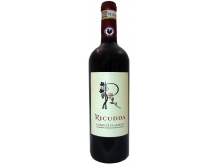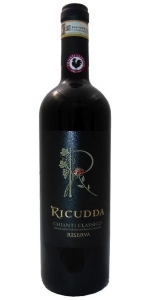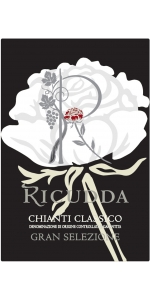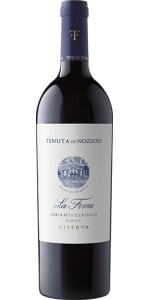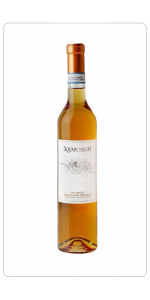Ricudda Chianti Classico 2019
| Country: | Italy |
| Regions: | Tuscany Chianti |
| Winery: | Fattoria Ricudda |
| Grape Type: | Sangiovese |
| Organic: | Yes |
| Vintage: | 2019 |
| Bottle Size: | 750 ml |
Ricudda Chianti Classico Riserva 100% Sangiovese.
Deep ruby red color.
The wine shows an intense and persistent bouquet, with notes of berries and spices such as licorice and black pepper. Well-harmonized hints of oak.
In the mouth, it is well structured and balanced, complex, persistent with notes of red fruits and spices such as black pepper and licorice.
Pair with grilled red meats, steak, game of hair and feather, stewed and roasted, aged cheeses hard like pecorino.
Wine with great structure, intensity and complexity.
Intense aromas of toasted oak, ripe red fruits, accompanied by spices and balsamic notes.
Aged 24 months in Oak barrels from forrests in the center of France.
Pairs well with grilled meats, game meat and aged hard cheeses.
Intense ruby red color with purple tints.
On the nose, the wine shows some intense notes of red fruits, especially cherry and slight hints of oak.
In the mouth, it has a good structure, great softness and it is pleasant to drink. Predominant notes of red fruits, with slight spiciness.
Pair with first courses with game, grilled meats, fresh and aged cheeses such as pecorino.
Ruffino Romitorio di Santedame Chianti Classico Gran Selezione DOCG is made from 90% Sangiovese, 10% Colorino.
Romitorio di Santedame, a limited-production Gran Selezione from Castellina in Chianti, pays homage to a rich history while embracing a bright future. It originates from a single vineyard within the Chianti Classico's "golden basin" (Conca d'Oro) and is crafted from an exclusive blend of Sangiovese and Colorino. The latter is a native Tuscan grape variety that was nearly extinct but has experienced a revival through dedicated research and promotion efforts.
Fruity aromas typical of Sangiovese, including black cherry and ripe plum, with violet and complex chocolate and black pepper notes. The palate offers sweet tobacco and balsamic hints, while its balanced structure with refined tannins and lively acidity makes it suitable for extended aging.
Review:
You feel the oak here, suggesting vanilla and clove character, but it’s very well complemented by the dark fruit, ranging from blackberries to mulberries to dark cherries. Full-bodied, dense and decadent with a regal structure and muscular tannin backbone. The acidity cuts nicely through on the long finish and provides freshness. Drink from 2024.
-James Suckling 94 Points
Tenuta di Nozzole La Forra Chianti Classico Riserva is made from 100% Sangiovese.
Located north of the village of Greve in the heart of the Chianti Classico region, the Nozzole estate covers a striking, rugged, mountainous area of about 1,000 acres at 984 feet in elevation. In order to obtain concentration and complexity in the wine, yields are kept low. The grapes are hand harvested, destemmed and crushed. Fermentation is initiated on the skins in temperature-controlled stainless steel tanks, followed by a maceration period to draw out color and tannins. The wine is racked into stainless steel tanks for malolactic fermentation before aging in oak vats and in bottle before release. The wine is bottled on the estate.
The 2020 vintage was characterized by a basically cold period between April and May and by a generally warm and dry climate until July. The initial slight delay of the vegetative cycle has been recovered since the summer. The sudden increase in temperatures, especially for the later varieties where the fruit set had not yet ended, has favored a production characterized by sparse and light bunches. The stable and sunny climate of the months of August and September allowed the grapes to complete ripening in optimal conditions.
- A classic, traditional Chianti from the Folonari family, making wine since the 1700s
- Matured in oak barrels
- Estate bottled, from a highly regarded estate
Review:
Attractive on the nose with cherries, red berries, dried herbs and baking spices. It’s medium-bodied with fine tannins. Harmonious and poised with a refined character. Weightless and agile. Polished and succulent finish.
-Wine Enthusiast 93 Points
Bojola Vin Santo del Chianti Classico is a fortified dessert wine made from Malavasia del Chianti and Trebbiano Toscano varietals.
Amber in color, intense nose with strong notes of dried fruit, accompanied by hints of walnut and juniper. Dense mouth feel with notes of dried fruit and quince jam.
Pairs well with desserts, biscuits, dried fruits and cheeses.
Intense ruby red color with purple tints.
On the nose, the wine shows some intense notes of red fruits, especially cherry and slight hints of oak.
In the mouth, it has a good structure, great softness and it is pleasant to drink. Predominant notes of red fruits, with slight spiciness.
Pair with first courses with game, grilled meats, fresh and aged cheeses such as pecorino.
Review:
"A very fine riserva with black-cherry, walnut with some cedar aromas and flavors. It’s medium-bodied with lovely tension and a fresh finish. Racy and refined. From organically grown grapes. Drink or hold."
- James Suckling (June 2022), 93 pts
The Ricudda Farm is located along a secondary route of the ancient Via Francigena, which in ancient times was traveled by pilgrims who went from France to Rome and descended from the ridge of Castellina in Chianti towards the main routes of the Val D’Elsa.
It takes its name from the French Coude / Couder / Recoude, which has the meaning of “elbow, bend”.
The name of the farm can therefore be traced back to the "elbow" conformation of the farm land.
The Fattoria has been producing wine since the 15th century and is one of the oldest farms in the Chianti area. It is located in the municipality of Castellina in Chianti about halfway between Florence and Siena, at an altitude of about 360 m a.s.l. The farm and its grounds boast almost 800 years of history, from the first known acquisition a few years before 1300 by Bartolomeo di Grazia, a Florentine citizen of the time, who started production until our acquisition. The Squarcialupi family, the most powerful family in the history of Chianti, is also among the owners of the land. In 2016 the company
was acquired by the Bojola - Australi families with the aim of converting production towards a 100% organic product. 6 hectares of new vineyards were replanted, modern equipment was purchased and the old farm that houses the farm and farmhouse was renovated. The result is a production of high quality Chianti Classico with Sangiovese grapes and organic olive oil.
Gundián is a local surname & the name of several Galician villages (3 in the area) as well as a famous bridge in Galicia - thus the bridge graphic on the label. The Gundián Bridge, also known as the Gundián Viaduct, is a bridge that spans the Ulla river pass, on the old railway line between Orense and Santiago de Compostela.
Clean and bright wine, straw yellow color with greenish flashes. On the nose, it has fruity and floral aromas of high intensity, especially apple and stone fruits (apricot). In the mouth, the freshness and youth of the Albariño stand out with a well balanced acidity which makes it savory, sweet and glyceric.
Xavier Vignon Cotes du Rhone Rouge Vieilles Vignes is made from 70% Grenache, 15% Mourvèdre and 15% Syrah
Grenaches are almost hundred years old, Mourvèdres more than 60 years old and Syrahs are 45 years old in average.
There's a spicy, green peppercorn edge to the Cotes du Rhone Vieilles Vignes. It's medium to full-bodied, with svelte, supple tannins and plenty of plummy fruit that exhibits more savory notes and spice on the long finish.
Review:
"The deep black-cherry and ripe-blackberry fruit, plus the full, soft body push this to the edge of sweetness on the palate. However, the gentle dry tannins at the velvety finish just keep it on track. A style that now seems a bit dated, but plenty of wine drinkers love this. Drink now."
- James Suckling (March 2022), 90 pts
Henschke Henry's Seven Red Blend is made from 72% Shiraz, 13% Grenache, 12% Mataro, 3% Viognier.
20th ANNIVERSARY VINTAGE
Deep ruby with violet hues. Lifted raspberry, red currant, mulberry and Satsuma plum, with floral notes of violets, lavender, crushed flowering herbs and anise, pepper and mace spice. A rich and intense palate of well defined, concentrated red fruits; red currant, cut plum and spicy wild berries, give way to crunchy mid palate, firm-edged velvety tannins and excellent length.
Review:
Aromas of black fruit and green tobacco with bark and wet-earth undertones, following through to a medium to full body, creamy tannins and a juicy, savory finish. Intense and balanced.
-James Suckling 95 Points
Roland Champion Champagne Brut Rose Grand Cru NV is the blend of 33% Chardonnay, 33% Pinot Meunier and 33% Pinot Noir.
The Champagne rose shows an orange salmon color coming from the red wine base. The pinot meunier brings red fruit aromas of strawberry and raspberry with hints of spices. The palate is juicy and harmonious with good depth and minerality. A delicate balance between Chardonnay, Pinot Meunier and Pinot Noir.
It is a blend of 93% White juice (made from 33% Chardonnay, 33% Pinot Meunier and 33% Pinot Noir) and 7% Pinot Noir red wine. The grapes used to produce the Coteaux Champenois red wine are coming from their vineyards near the Village of Verneuil.
Pioneiro Red Wine Vinho Regional Peninsula de Setubal is made from 60% Castelao (also known as Periquita), 30% Aragones and 10% Syrah
Aged 5 months in French oak barrels
The story of this wines begun more than a century ago, with the pioneering dream of Venâncio da Costa Lima: to bring good wines to every corner of Portugal. Pioneiro wine brand was created to pay homage to his vision.
What's Unique? Pioneiro (meaning “pioneer” in Portuguese) wine vintage style label pay homage to the founder’s dream, dating back to 1914. But in a relaxed, casual way, typical of this wine producer mood.
Intense garnet color, complex nose with touches of ripe fruit, jam and spices, full-bodied flavor and a very balanced finish.
Castelao: as the most widely-grown red grape variety in Portugal it is still often referred to in Portuguese as "Periquita" or "Joao de Santarem", although that name is legally owned by José Maria da Fonseca in the Setúbal Peninsula outside of Lisbon. It is highly adaptable to different climatic conditions and its remarkable versatility enables winemakers to make a range of wines – from the easy drinking and quaffable reds and rosados to the powerful and intense reds perfectly suited to lengthy cellaring. Castelão comes into its own and is most expressive in the Sétubal Peninsula, where it makes meaty and intense wines with aromas of red berries and blue flowers that marry well with the deft use of oak.
Made from 15 year old vines planted on sandy soils.
Classic vinification at controlled temperature (25 °C) with prolonged maceration for phenolic extraction. Wine went through malolactic fermentation.
It was aged 5 months in French Oak barrels.
Wine was slightly filtered before bottling to avoid sedimentation in the bottle and to ensure stability.
Pasta, Cheese, red meat and game.
- back
Intense ruby color of high layer with garnet edge, clean and shiny. Intense nose that, from the beginning, transmits complexity, penetrating, with aromas of black fruits, blueberries and currants, undergrowth, roasted memories, toffee, coffee powder, liquorice, cloves, vanilla and lebanese cedar. Mouth with freshness and balance, with tannins ripe and creamy, which highlight its elegance, with a step harmonious and intense. Long and pleasant aftertaste, with a great variety of balsamic and spicy memories.
Review:
The old-vine component of the El Otero parcel, running to around seven hectares, supplies the fruit for this ageworthy Tinto Fino. After a frost-induced break in 2017, it's back with interest in 2018. Aged in new French oak, but not dominated by the wood, it's a finely judged red from Julio Sáenz with notes of blackberry and tangerine, filigree tannins and a long, textured finish. 2023-33
-Tim Atkin 96 Points
-
Le Jade Picpoul de Pinet is made from 100% Picpoul de Pinet
Pale straw color. Delicate white flower, citrus and juicy pear aromas. Fresh, crisp, and bright acidity with mineral and saline accents. Well-balanced and easy-drinking.
A refreshing treat laced up with snappy food-friendly acidity.
Picpoul Le Jade makes a classic match with oysters on the half shell and goes very well with exotic food in general. Picpoul means lip-smacking good.
SOIL : Clay and limestone soil just a few kilometres from the reputed Etang de Thau (salted water lagoon) overlooking the Mediterranean town of Sète.
VINIFICATION : Grapes are harvested at 12°- 13° maturity
Skin maceration for several hours
Selection of drained juice after undergoing pneumatic pressure.
Cold double decantation.
Thermoregulated fermentation at 16°C
No malolactic fermentation.

